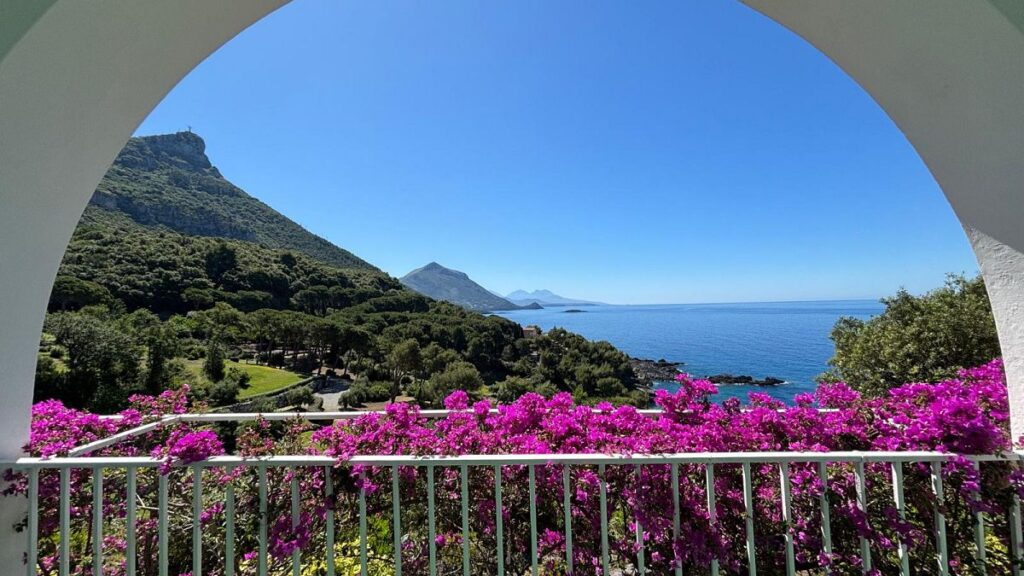At the railway station in Salerno, the city known as the eastern gateway to the Amalfi Coast, a crush of floppy-hatted tourists crowds the platform where the train to Naples will arrive.
On the opposite platform, only an elderly lady and a family with two small children wait with me for the train heading in the other direction.
We board the nearly empty regionale service, which winds down the Tyrrhenian coastline, arriving in Maratea after just under two hours.
It’s a grab-a-window-seat kind of journey, travelling through valleys flanked by thickly forested angular hills on one side and the glittering sea on the other.
There are plenty of tempting seaside stops en route, but I’m headed to the short strip of coastline of the Basilicata region that is squeezed between Campania and Calabria.
Italy’s ‘forgotten’ southern region
Basilicata is one of Italy’s ‘forgotten’ regions, historically a poor area with an economy that revolves around agriculture.
It remains predominantly underdeveloped in terms of tourism – many would say thankfully so.
Most international visitors only recently became aware of its existence thanks to the awarding of its eastern city of Matera as European Capital of Culture in 2019.
This troglodyte warren of caves now receives many tourists, but mostly those hopping over the border from the more established destination of Puglia.
Over on the western side, the (confusingly similarly named) town of Maratea is a breathtakingly beautiful yet remarkably peaceful spot where Italians in-the-know have holidayed for decades.
Although neither upper Maratea nor the waterside Porto di Maratea can claim the precipitous drama of Amalfi Coast towns like Positano, the coastline stretching out on either side is, for me, superior in terms of its natural landscape.
Plus, even in the height of summer peak season, it is a dreamy oasis of tranquillity and slow living, devoid of crowds.
Quiet luxury at a historic hotel
For many Italian holidaymakers, Hotel Santavenere is synonymous with Maratea. The property, the only five-star on the coastline, opened in 1953, and has had a major influence on the kind of tourism the area promotes and attracts.
It was practising quiet luxury long before it became a buzzword on social media. From the electric golf buggies that pick guests up at the station a few minutes away to the natural pebble beach, it reassures guests it hasn’t changed its approach.
Hotel Santavenere feels like the kind of discreetly glamorous accommodation many tourists want to find along the Amalfi Coast, only to find few can offer that sense of space, solitude and serenity without a hefty price tag.
In fact, Santavenere’s surrounding parkland that slopes steeply to the sea is something the Amalfi Coast’s clifftop properties cannot offer.
In the early morning, I wander down the snaking trail through the maritime pine-shaded garden to the shore, preceded by darting rustles of iridescent green lizards dashing into the undergrowth.
At the water’s edge, sun loungers are laid out in little natural terraces amongst the rocks, and a ladder gives access to the dark blue sea.
A little way along is the natural pebble beach with shallow water to paddle in. The hillside rises steeply above, tangled in trees and crowned by an ancient watchtower.
A pretty port and a hillside hike
Halfway back up the lung-busting ascent through the gardens of the hotel, there is a gate opening out to a curving road.
This winds down to Porto di Maratea, a clutch of houses gathered around a little marina. Lining the road that curves around the port are little stores like a pottery workshop and a boat supplier.
The town also has a surprising number of excellent restaurants, including the Laterna Rossa, which serves refined dishes like a cannolo with raw prawns, ricotta mousse and gazpacho or pasta stuffed with catch of the day, local provola cheese and lemon.
High up on the hillside above is upper Maratea, a town of narrow, sloping streets, ice-cream coloured houses and an impressive 44 churches, hugged by rugged mountains.
I sit in the square with a summery-looking spritz on a maiolica table, preparing myself for the afternoon hike up to Maratea’s most iconic monument.
A little over an hour’s climb up from the town is a 21-metre-high white statue of Christ the Redeemer, his arms outstretched.
It’s hard to say whether Rio’s version or Maratea’s has a better view – from the top, I take in a panorama of the coves and juts of the coastline, the forested mountains, and the Tyrrhenian Sea stretching to the horizon.
Discovering Basilicata’s ‘cucina povera’
My favourite view of Maratea’s coastline, however, is from the terraces of Hotel Santavenere. An abundance of bold purple bougainvillaea means every vista is framed by flowers, including the al fresco dining area.
As the light fades, I take a culinary journey through Basilicata with chef Giovanni Fiorellino’s new menu. I begin with the raw amberjack with Lucanian (the ancient name for the Basilicata region) black pig guanciale, and ‘formaggio dei poveri’ – fried and seasoned breadcrumbs known in Basilicata as the cheese of the poor.
I follow it with the palette-awakening beetroot risotto with mussels, buffalo blue cheese and coffee powder, and then Lucanian pork shoulder with a reduction of the local Amaro Lucano liqueur.
On my post-dinner walk down to Porto di Maratea, all I can hear are the chirping cicadas and the waves below – a far cry from the honking of buses and crowded pavements of the Amalfi Coast.
Read the full article here

